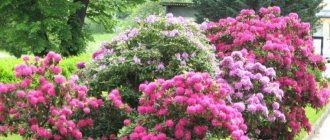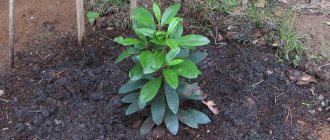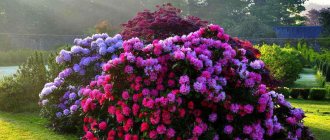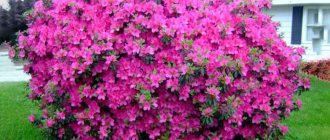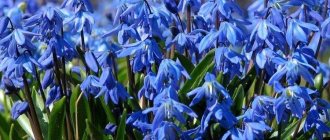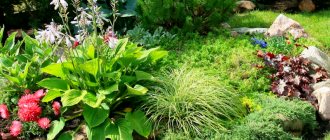Homeland of the plant
Rhododendron Katevbinsky appeared in Europe in 1809, it was brought from North America. It was one of the first introduced species, which spread very quickly due to its unpretentiousness and winter hardiness.
Full size shrub
For your information! At the moment, the species is actively used not only in landscape design, but also in breeding programs to obtain new evergreen frost-resistant varieties.
In nature, rhododendron can be found in North America, in particular in its eastern part, in the Allegheny Mountains. Shrubs form entire fields in open areas or grow in groups among forests. Emerald green specimens are also common in Japan.
The flower came to Latvia in the mid-19th century; in the climatic conditions of the Baltic states, rhododendron blooms and bears fruit profusely. Thanks to the shrub’s ability to withstand frosts down to −30°C, it can be found in the Far East and Kamchatka.
Diseases and pests
Among the diseases, rhododendron is threatened by fungal diseases - spotting, cancer, chlorosis and rust:
Spraying with a solution of copper sulfate and Bordeaux mixture helps get rid of spotting and rust.
Iron chelate, which is dissolved in water intended for irrigation, will help cope with chlorosis.
If the bush becomes cancerous, then all diseased parts must be removed, or the plant must be completely eliminated. As a preventative measure, spraying with Bordeaux mixture twice a year will help - in early spring and late autumn.
Dangerous pests include mealybugs, weevils, scale insects, spider mites, bedbugs, rhododendron flies, slugs and snails. They are combated using appropriate chemicals.
Reproduction methods
Like many other garden plants, adult rhododendron grandiflorum can be propagated in several basic ways: by seed, using cuttings or layering. Each of them has its own characteristic features, which the gardener should know about immediately before starting work.
Seeds
The seed method of propagating this crop is deservedly considered one of the most labor-intensive, so most gardeners resort to it only in extreme cases.
However, this does not mean that the description of the planting process is devoid of relevance, so every gardener should know what stages it consists of:
- To begin, prepare a suitable planting container with drainage holes at the bottom and fill it with peat or heather soil mixed with sand in a 3:1 ratio.
- Level the surface of the substrate and spread the seeds without pressing them deep into the soil (there should be a distance of at least 2 cm between adjacent seeds).
- Sprinkle the seeds with a small amount of sand and cover the seedling box with glass or plastic film to create a greenhouse effect inside.
Further care of the seedlings consists of periodic ventilation and moistening of the plantings with a spray bottle. In suitable conditions, the first shoots of rhododendron Grandiflorum will appear after a month. After two true leaves have formed on the young stems, it is worth planting the plants in different containers to form a good root system for each specimen.
For the entire next year after planting, the seedlings are grown in greenhouse but cool conditions, and only the strengthened seedlings are moved to prepared beds in the open ground. With this method of cultivation, you should not wait until 6–8 years for the first flowers to appear on the bushes.
By cuttings
Suitable planting material for propagating rhododendron by cuttings will be semi-lignified segments of shoots, 5–8 cm long. The lower leaves of these parts are removed, and the cutting itself is lowered into a root formation stimulator (cut down). The future shrub must remain in “Kornevin” or “Epin” for at least 16 hours, after which it is transferred to a mixture of peat and sand, combined in a 3:1 ratio.
As when planting seeds, the cuttings are covered with polyethylene or an inverted jar during rooting to create greenhouse conditions. The soil under the shelter should not dry out, so soil moisture and periodic ventilation are mandatory aspects of productive growing of cuttings.
The average rooting period is 2–4 months, but in the cold season it is advisable to place the plants in a cool room, with temperatures of +8…+12°C. In the spring, the cuttings can be transplanted into open ground along with a seedling container, and after complete rooting, they can be moved to a permanent growing place, having already been removed from the box.
Did you know? Certain varieties of the described plant (for example, R. ponticum and R. luteum) should not be grown near the apiary. The pollen of the flowers of such bushes contains toxic substances, which, if they get into honey and are subsequently consumed by humans, can cause not only a runny nose and cough, but also hallucinations.
By layering
Obtaining new rhododendron Grandiflorum plants using layering is deservedly considered the least labor-intensive way to propagate a plant, and all that is required from the gardener is:
- Dig a ditch up to 5 cm deep next to the bush.
- Select a healthy lower shoot of the mother bush.
- Place it in an organized trench and pin it to the ground with metal staples.
- Cover the main part of the branch with a mixture of soil and peat, and bring the remaining end above the soil surface and tie it to a wooden stake driven next to the bush.
Throughout the summer season, the cuttings are watered in the same way as the mother bush, and the next year, as soon as the buried part is completely rooted, it can be disconnected from the main plant and planted in a prepared area, like a regular seedling. Further care should be carried out in accordance with the general rules for caring for rhododendron.
Reproduction
Rhododendron can reproduce in several ways:
- Seeds that are best sown for seedlings in January. The seeds are sown superficially and germinate in the light at a temperature of about 20 °C. Transplantation into open ground - in the spring of the second year of life. The root collar cannot be buried.
- By layering . With this method, a small piece of bark is removed from the branch, after which it is pressed against nutritious and loose soil and secured with a staple. Over the course of a year, a fairly large layer grows. After another year, you can separate it and plant it in a new place.
- Cuttings, which, unfortunately, take too long to take root - it takes from 4 to 6 months.
Description
Rhododendron is a shrub reaching a height of 4-4.5 m. Its leaves have an elongated shape, rich green color with a glossy sheen. The lifespan and growth of rhododendron is approximately 100 years. The plant appears uniquely beautiful during flowering, when the entire bush is literally strewn with flowers with a radius of up to 3 cm. Their shape resembles a bell, they are collected in clusters of about 20 pieces. Flower colors are varied:
- white;
- cream;
- violet;
- red with a purple tint;
- lilac;
- lilac.
Katevbinsky rhododendron is planted in alleys near benches, at the turns of garden paths. This light-loving plant, however, can tolerate light scattered by tree foliage. The only thing the shrub is afraid of is drafts, so choose the place to plant it carefully. Rhododendron Katevbinsky was taken by breeders to develop the following varieties:
- "Grandiflorum";
- "Purpureum";
- "Roseum elegans";
- "Album";
- "Burso";
- "Homebush."
Grandiflorum ("Grandiflorum")
This is the most common variety of rhododendron, which was one of the first to be bred. It is distinguished by its resistance to frost down to -32 C and rapid growth. The crown span is approximately 3.5 m and the height is 3 m. The flowers have a purple hue with orange speckles and are odorless. Inflorescences appear in early summer.
Purpureum ("Purpureum")
One of the young varieties of rhododendron, bred on the basis of “Grandiflorum”. Therefore, it is also distinguished by frost resistance down to -30 C, strong and tough shoots. In the Urals the height is 1.5 m, and in warm areas up to 2.5-3.0 m. It does not shed its leaves in winter. Blooms in June with lilac-violet flowers.
Roseum Elegans
It is distinguished by its slow growth, delicate pink-purple inflorescences, resistance to frost, intolerance to winds and bright spring sun. The shrub is spreading, its shoots are strongly branched.
Album
So called for its snow-white flowers with an olive speck. It reaches a height of 2 m. It is resistant to frost, blooms in late spring - early summer. Can be used both for single planting and for creating compositions.
Boursault
The variety was bred in 1849 for cultivation in the northeastern United States. It is a fast-growing shrub, 2 m wide and up to 2 m high. It blooms in early summer with dark purple buds.
Homebush
This is the second name for deciduous rhododendron, which distinguishes it from previous evergreen varieties. It grows at an average rate and by the age of 10 reaches 1.5-2.0 m. It has original double, pointed pink flowers, collected in spherical inflorescences. Withstands temperatures down to -30 C, does not require shelter.
Description of Rhododendron Katevbinsky Grandiflorum
Rhododendron hybrid Katevbinsky Grandiflorum belongs to the Heather family. One of the oldest varieties of rhododendron, obtained at the beginning of the 19th century. It forms a spreading, highly branched bush 2-4 m high. The shrub is a fast-growing one, the annual growth is 8-12 cm. It forms a semicircular, dense crown. The size of Rhododendron Katevbinsky Grandiflorum in diameter is 2-3 m. It can grow in one place for about 100 years.
The bark color is brown. The leaves are medium-sized, elliptical, 7-8 cm long. They are dark green, shiny, and smooth on top. Below they are pale, leathery, without pubescence. The inflorescences are compact, uniting 13-15 flowers, 6-7 cm in size. The photo of the rhododendron Grandiflorum shows a purple tint of the flowers with an orange spot interspersed on the upper petal. The stamens are long and curved. Flowers without fragrance. The buds bloom in early summer.
Planting and care
Landing
Despite their apparent simplicity, rhododendrons are quite demanding in care and need to comply with certain growing conditions:
- acidic or slightly acidic soil,
- good drainage system,
- abundant watering,
- increased air humidity,
- no drafts.
All the variety of varieties does not tolerate drafts and direct sunlight, so it is very important when growing rhododendrons to choose the right location for its further growth. It would be good if it was diffused light from a coniferous tree with a taproot: in this way you will create a natural shelter from the wind and summer heat, and similar requirements in the soil will not take away nutrition from the young shrub. Do not plant Katevbinsky rhododendron near fruit trees, as they can actively take nutrients from the soil, and in the future this can lead to the death of the flowering beauty.
To avoid waterlogging of the root system and waterlogging of the soil during spring floods, plant rhododendron on a slight elevation.
Rhododendrons have an underdeveloped fibrous root, so they do not require deep planting. For planting small plants, depressions of about thirty centimeters are suitable, for larger ones - up to half a meter.
Remember, your green pet cannot tolerate excessively swampy soil, so pay special attention to arranging a drainage system in the planting hole. Expanded clay or natural pebbles can act as drainage
Rhododendron Katevbinsky prefers well-moistened soils, so to minimize injuries during planting and better rooting of the shrub, place the plant in water along with a lump of earth for several hours. Next, place the shrub in the prepared planting hole and water it generously until all the air bubbles come out, and sprinkle the plant with soil. When planting, make sure that the root collar of the plant is above the ground.
Care
After planting, further care consists of timely watering and fertilizing. The root system is located quite close to the surface of the earth, so to avoid injury to the roots, refrain from weeding the soil. To ensure better looseness of the soil and maintain its acidity, sprinkle rotted pine needles under the bush once every six months, but make sure that the neck of the plant is not covered with soil.
Rhododendrons do not require crown pruning, but to make it more elegant, many gardeners give it a spherical shape. Pruning always slows down the growth of the plant, so it is recommended to do it in late spring.
Landing rules
First, you should think about purchasing a seedling. So that the description of the variety does not deceive and the bush pleases with flowering for a long time, you need to choose the right planting material.
Important! Rhododendron should not be planted next to a plant that has shallow roots. This will inhibit the growth of the bush
When choosing, adhere to the following rules:
- Do not take adult specimens or rooted cuttings. They will not acclimatize well.
- The seedling must be 2 years old. The root system must be placed in a container.
- Healthy foliage. The leaf blade should have a greenish color and be evenly colored. You should not take a cutting that, upon examination, showed signs of necrosis.
Planting is carried out both in spring and summer. For Rhododendron Purpureum Grandiflorum, choose an area with diffused light. If the bush is planted near trees, leave a distance of 2 m.
If groundwater lies close to the surface, it is better to plant on an earthen hill, covering it with stones. After purchasing, the seedling is lowered with its rhizome into a bucket of water and held until bubbles begin to form. Then in the prepared hole they make a depression the size of the roots and carefully place the bush there
Work is carried out carefully so as not to damage the rhizome. Cover the top with earth, lightly compact it, water it and mulch it with pine needles.
Prepare the planting hole in advance, 3-4 weeks in advance. Since the root system of rhododendron is superficial, it does not need a deep hole. Its approximate dimensions are: diameter - 0.6 m, depth - 0.4 m. The dug hole is filled with prepared substrate.
Landing Features
Rhododendron Katevbinsky comes to the gardener's plot most often in the form of a seedling purchased at a garden center.
At the same time, for the successful cultivation of this shrub, the correct choice of seedling is important. There are often specimens on sale brought from Holland and France with a warm climate. Such seedlings are unlikely to take root in our climate zone.
For Russian latitudes, it is advisable to choose rhododendrons grown in similar conditions, for example, in nurseries in Finland.
You should not purchase rooted cuttings or adult bushes of the plant.
It is best to opt for a two to three year old seedling with a root system placed in a container. Before purchasing, the bush must be examined. A healthy rhododendron leaves have an even green color without signs of chlorosis or necrosis.
The plant can be planted in the spring, as well as during the summer until the end of August. You should choose a place with a lot of diffused light. An area in partial shade under a tall, spreading tree is ideal. The bush should grow at a distance of no closer than 2 meters from the tree.
It is not advisable for rhododendron to be located next to trees that have a shallow root system - they will inhibit the rhododendron. The best neighbors of the shrub are spruce, pine and larch. It is necessary that the site is protected from cold winds.
For rhododendron, it is very important what kind of soil the planting hole will be filled with.
Like all heathers, it needs loose, peaty and humus-rich soil with an acidity pH of 4.5 to 5.5. To prepare it, it is best to take brown high-moor peat with suitable acidity. Three parts of peat should be mixed with two parts of pine litter and one part of coarse sand.
If necessary, coniferous litter is replaced with rotted leaves or rotted (not fresh!) sawdust obtained from coniferous trees. This soil composition has the correct acidic reaction, breathability, moisture capacity and does not caking. You can also use commercial rhododendron substrate.
Rhododendron Katevbinsky has a compact root system, so it does not require a large planting hole. Its optimal dimensions are 60 cm in diameter and 40 cm in depth. It is recommended to prepare the pit a couple of weeks before planting. Such a pit requires about 8 buckets of fertile soil. It is thoroughly mixed, the planting hole is filled with it and compacted.
Before planting, the root ball of the seedling is lowered into a bucket of water, holding it there until the bubbles stop appearing.
Next, at the site of the planting hole, dig a hole the size of the root ball, install a seedling in it and fill the roots with the extracted soil so that there are no voids left between them.
When planting, the root collar is not buried. The bush should be planted at the same depth as it grew in the container. At the end of the work, the soil is well watered and mulched with pine needles or chopped wood chips. When planting, you should handle the root ball very carefully and try not to damage the mycelium living on the roots, which provides the plant with adequate nutrition.
How to care for an exquisite plant
Like any cultivated plant, azalea requires, although simple, certain care.
It should be plentiful, especially for young seedlings. The intensity of watering is determined by the appearance of the top layer of soil. That is, if the soil outside looks dry, then the plant needs to be watered. In addition, garden rhododendron prefers increased humidity, which is created by spraying the flower with a spray bottle. This procedure is carried out during the day in very hot and dry weather. Also, for additional moisture, you can use several open vessels filled with water, which are placed near the plant.
Loosening the soil
Produce regularly after each watering. This will preserve moisture and saturate the soil with additional oxygen, which is necessary for the normal development of the root system and the entire plant as a whole.
To loosen the soil, a hoe is usually used, with which the upper layer of soil near the trunk is carefully loosened so as not to injure the root
Fertilizer application and soil composition
Azalea is very demanding on the composition of the soil, therefore, before planting the plant, it is necessary to select its composition correctly. The most acceptable option is soil consisting of:
- humus;
- sand;
- peat;
- coniferous land. This substrate consists of rotted needles of pine, larch, fir or other coniferous trees. Such soil can be purchased at garden stores or collected independently in the forest under coniferous plants;
- turf land. Such soil is prepared from grass that rots over a certain period of time;
- leafy soil. This substrate consists of rotted leaves of bushes and trees. It can also be purchased in stores or collected under any tree.
To prepare a high-quality earthen composition, all of the above elements are mixed in equal parts. This will create acidic and breathable soil, which is best suited for growing garden azaleas.
You need to start fertilizing the plant a month after it is planted in open ground. Subsequent feedings are carried out every twenty days. As fertilizers, you can use organic and mineral additives intended for ornamental flowering crops, which are easy to find in any specialized store.
Instructions for planting rhododendron Katevbinsky "Grandiflorum"
- Water the seedling generously, and if the root ball is dry, then soak it in a bucket of water for 40-50 minutes so that all air bubbles come out and it is saturated with moisture.
- Dig a planting hole approximately twice the size of the seedling's root ball (depth - 34-40, width - 45-60 cm).
- Make a drainage layer at the bottom of the hole from broken red brick, sand, fine gravel, pebbles or crushed granite - 7-8 cm.
- Pour a little soil mixture (8-10 cm layer) and pour 4-5 liters of water into the hole so that the bottom layer is well saturated.
- Then place the seedling so that the root collar is 3-5 cm higher than the ground level. And after compacting the soil mixture and watering, the base of the bush will be exactly at ground level. Gradually fill in the substrate and compact it.
- Water the tree trunk circle with 6-8 liters of water. If the soil settles too much, add the mixture.
- Apply a 6-8 cm layer of mulch from peat, heather soil, pine needles or leaves of oak, birch or linden to retain moisture, increase acidity and the amount of humus. The root collar cannot be covered; it is better to sprinkle it with coarse sand to prevent it from rotting.
- Cover the seedling with a newspaper cap, cloth or net for 7-12 days. Then drive a stake for support, tilt it towards the winds and tie the seedling.
For more details, see the special article:
Place and soil for planting rhododendron Katevbinsky "Grandiflorum"
Before purchasing a seedling, it is important to find a comfortable place for it and learn how to properly prepare the soil mixture. These factors will become the basis for the future excellent development and delightful flowering of the “rosewood”.
Landing place
Favorable conditions: quiet place with light partial shade from tall trees. Good lighting is required in the morning and evening, and from 11.00 to 16.00 shade or protection from sunlight is required.
Therefore, to plant the Katevbinsky rhododendron “Grandiflorum”, it is better to choose the northern or eastern side.
The selected area of the garden should not be flooded in the spring when the snow melts and should not be swampy.
Choice of neighbors and landing distance
Neighbors of "Grandiflorum" must have a taproot system, since it has a superficial one, so that nutrient deficiencies do not occur.
Good surroundings: spruce, larch and pine (as in nature). And also pear, oak, pine, apple, cherry. Prohibition: elm, birch, willow, chestnut, maple, linden.
- Minimum distance to large shrubs and trees: 2-3 meters, from a building up to 7 years (then almost no lime is released from the solution) - 1.5 meters. When planted in a row - 130-180 cm.
Soil acidity and soil mixture for planting
Optimal soil acidity for rhododendron, pH: 3.0-4.5. In a neutral environment, the growth and flowering of the Katevba rhododendron is significantly inhibited.
The main components of the nutrient substrate: heather soil, acidic high peat, deciduous soil (humus) and pine needles. The presence of all components is not necessary; it is more important to maintain an approximate ratio: 50/50 organic matter and garden soil from the dug hole.
- High peat, garden soil (loam or turf soil) and sand 3:2:1. A reliable option is the “gold standard”.
- High-moor peat, leaf soil and coniferous litter, sand – 3:2:1:1.
Additionally, you need to add 30-40 grams of complex mineral fertilizer.
Rhododendron Katevbinsky "Grandiflorum" (Grandiflorum)
Characteristics of Katevba rhododendron Grandiflorum
When growing rhododendron in most of the Russian Federation, flowering bushes can be expected as early as May. The inflorescences remain on the plants for about a month, and then they are gradually replaced by fruits in the form of seed pods. Full ripening of the seeds can be expected in October.
As for the winter hardiness of the described evergreen shrub, adult plants can easily tolerate winter temperature drops down to -32°C without shedding their leaves. Even during cold weather, the moisture evaporates from them, so it is worth continuing moderate watering of the shrubs until the soil freezes.
If the thermometer column drops far beyond the zero mark, the leaf plates of the rhododendron begin to curl and droop, which provides the plant with a reduction in moisture loss.
The Grandiflorum variety does not make too many demands on planting and care, but in order to get the most ornamental shrub possible, it is still worth knowing about some of the cultivation features of this particular varietal variety of this plant.
Reproduction methods
The hybrid Grandiflorum Purpureum can be propagated by seeds or vegetatively. Cuttings can be harvested from semi-lignified branches from mid-June. The shoot is cut 5–8 cm long, the leaves on the lower part are removed, and 2–3 pieces are left on the upper part. Since cuttings do not root well, it is recommended to soak them in a growth stimulant solution for 12–16 hours before planting.
The seed method is more labor-intensive. First of all, the seed material is subjected to stratification (kept in damp sand for 1–2 months at a temperature of 1… 5°C). Before sowing, the seeds are washed and soaked for 8–12 hours in a growth stimulator. Seedlings are germinated in a substrate of peat and sand. Shoots appear in 6–8 days. After this, the seedlings are provided with sufficient light and an air temperature of 15... 20°C.
Important! For the first year, seedlings grown from seeds are kept in greenhouse conditions
The simplest method is propagation by layering. In the spring, a small depression is made near the mother bush into which a nutrient substrate is added.
On the young shoot, cuts are made in several places, the foliage is removed into parts that will be placed in the ground, carefully tilted and placed in the hole. Using staples or hooks, the layering is secured and sprinkled with substrate.
Throughout the season, the soil needs to be moistened and, if necessary, topped up. By mid-summer you can see the first signs of rooting. It can be transplanted from the mother plant only next spring. The mother bush can be reused for layering only after 5–10 years.
Rhododendron Grandiflorum Purpureum is an amazing plant that is well cultivated even in unfavorable climatic conditions. With minimal care and proper planting, you can get a magnificent lush shrub in your garden.
Care requirements
Like other plants, azalea needs regular watering and weeding. However, this shrub does not tolerate loosening the soil, because after such a procedure the mycelium of the rhododendron can be damaged. It is better to remove all weeds near the plant by hand.
Due to the fact that the shrub does not tolerate dry soil, you need to take care of regular and abundant watering of the rhododendron (at least once a week).
One large bush requires approximately 50 liters of water. There is no need to rush when watering; it is better to make sure that the water is well absorbed into the soil. The plant loves soft water, like rain. To soften and acidify well water, you can use acetic or citric acid.
For a young plant (in the first year) no feeding is required. But, starting from the 2nd year, it is recommended to use long-acting fertilizers (for example, Pokon) every spring.
When choosing a fertilizer for rhododendron, you should avoid using chlorine or calcium.
Despite the fact that the shrub has good frost resistance and recovers quickly, large temperature changes can harm azaleas. The result of this is increased fragility of the bushes. To prevent this, you need to mulch the rhododendron root circle.
If the bush is large in size, it is better to tie it up and secure it on a reliable support.
Rhododendron care requirements
Rhododendron Dahurian Far East
The soil should always be moderately moist, since drying out or stagnant moisture is detrimental to the plant. In places where water accumulates after precipitation, it should be drained. The soil under the bush is never loosened or dug up. Acidity is maintained with coniferous mulch, citric acid or special acidifying compounds for rhododendrons. The shrub responds gratefully to sprinkling with natural water, rainwater or taken from reservoirs.
Note! After wintering, sanitary pruning is carried out, removing frozen and broken shoots. Formative pruning is not required, since the bush already forms a neat rounded crown.
Flower pruning
Since rhododendron is grown mainly for its lush, large-flowered inflorescences, each of them must be carefully removed immediately after flowering. The withered inflorescence is cut off, paying attention to the new shoots located near the base and trying not to touch them.
Thanks to timely pruning of flowers, the shrub's nutrient reserves will be used not for the formation of seeds, but for the laying of new flower buds. In addition, thanks to this procedure, the decorativeness of the rhododendron increases - 2-3 young shoots are formed in place of the removed inflorescence.
Preparing rhododendrons for winter
Before the first autumn frosts arrive, rhododendron bushes are sprayed with preparations containing copper as a preventive measure for diseases. Each plant is covered with peat to a height of 20 cm.
The evergreen Katevbinsky rhododendron, called grandiflorum, can easily overwinter without shelter, but then it risks sunburn and drying out, and the stems will be damaged by snow. To preserve the plant, a frame is installed around it and covered with non-woven covering material.
Preparing a winter shelter for rhododendron
Kinds
Based on the original species of Katevbinsky rhododendron, hybrids have been bred that are distinguished by winter hardiness, the shape of the bush and inflorescences, and the color of flowers. Popular ones are:
- Album (Catawbiense album).
- Grandiflorum.
- Katewbinse Burso.
- Cunningham's White.
Despite all their differences, they have common features that emphasize their belonging to this plant species.
Album
The shape of the bush is elongated upward, its height is 3 meters. It blooms with large white inflorescences with a yellow center. Flowering lasts from the end of May to the last days of June. Withstands winter temperatures down to -30 degrees.
Grandiflorum
The most common type of Katevbinsky rhododendron, the first variety bred on the basis of a wild species. The bush has the shape of a ball with a diameter of 2.5 meters. Blooms profusely from the beginning of May for a month. Flowers are white, pink, purple, collected in inflorescences. Tolerates temperatures down to -32 degrees.
Bourso
A rhododendron hybrid, very winter-hardy (down to -32 degrees), retains all the properties of the species. The bush has a spreading shape and tends to grow in breadth.
White
The rhododendron hybrid Cunningham's White is called White. The snow-white flowers have a central petal strewn with small purple spots. The length of the petal is 5 centimeters, 9 flowers are collected in the inflorescence.
Detailed description
This is one of the most winter-hardy and tallest varieties. Feels great in partial shade, blooms very elegantly, covers the foliage with flowers, a real “Pink Tree”.
- The crown is dense, usually in the shape of a semicircle, its diameter can reach 2 m.
- The leaves are shiny, leathery leaves of a dark green color, elongated ellipsoidal in shape (can reach 15 cm in length).
- The bark on the stem and branches can be dark gray or brown.
- The flowers of Rhododendron Katevbinsky are similar in shape to wide bells of a soft lilac color with yellow patterns; hybrid varieties have a very wide variety of colors, including white, pink, red, crimson and others. The inflorescence turns out to be very lush, it consists of 20 flowers, and each flower is approximately 5 - 6 cm in diameter.
- Roots are located shallowly, no lower than 40 cm from the surface.
What is the difference from other types?
Rhododendron Katevbinsky, unlike many other types of evergreen Rhododendrons, has inflorescences with a wonderful subtle aroma. It is also worth noting that during the flowering period it blooms so magnificently that it has been given the name “Rose Tree”.
- The hybrid variety Katevbinse Burso is one of the most winter-hardy species, can withstand up to 30 degrees below zero, and likes to grow wide. Lilac-purple flowers are collected in large lush inflorescences.
- Purpureum hybrid is a spherical shrub with beautiful purple inflorescences (the color is very juicy), the inflorescences are large - 15 flowers each, odorless.
- Album (Catawbiense album) - this species has a slightly different shape - it is elongated upward, reaches a height of 3 m, its large flowers are white with a yellow core.
- When and how - flowering of Rhododendron Katevbinsky occurs in May - June, lasting about one month. The flowering is very intense, the inflorescences consist of 15 - 20 large flowers of various shades.
- Care before and after flowering - water well and do not forget about fertilizing, thanks to them the bush will not be depleted.
- What to do if it doesn’t bloom - it’s better to replant it in a more favorable place and water it well.
What should the soil be like?
You need loose, fertile soil, preferably slightly acidic (maybe acidic), moist, but without stagnant water.
Planting can be different: seeds and seedlings. When purchasing seedlings, it is better to choose self-rooted ones; they can be planted in spring and summer, preferably immediately in a permanent place in the garden, in partial shade.
Seeds can be sown from January to March in nutritious soil (necessarily loose), do not bury them deeply, you just need to press lightly
Water very carefully, it is best to spray the water. Before germination, the container with seeds must be covered with glass and provided with lighting 12 hours a day using a phytolamp. After the seedlings appear, remove the glass, continue to maintain humidity and lighting, and when 3 leaves grow, plant the seedlings in separate containers. In the spring or early summer, these “babies” can be planted in the garden in a suitable place protected from the winds (or a year later in the spring). They will begin to bloom after 2 or 3 years, with this planting method you can get a plant with improved properties
They will begin to bloom in 2 or 3 years, and with this planting method you can get a plant with improved properties.
Temperature
The lowest temperature that this shrub can withstand is 30 degrees below zero, and the highest is 30 degrees above zero, while the optimal temperature is from minus 10 to plus 25 degrees.
Rhododendron is very moisture-loving; in extreme heat it definitely needs deep watering about 2-3 times a week. It will also be useful in hot weather to sprinkle the bush with a hose only on the leaves. The water should be soft, preferably acidified.
- Twice a season you need to apply organic fertilizers in this form - a bucket of cow manure and rotted compost per bush.
- The rest of the time, fertilize with an aqueous infusion of organic matter; it is also good to add double superphosphate during the budding period; flowering will be even more magnificent.
Remove only faded buds.
It is best to replant the plant in the spring.
You need to decide in advance on the location and prepare the planting hole; it should be wide and deep enough - about 2 times larger than the root system of the bush. Add a nutrient substrate of peat, humus and well-rotted manure into it, mix everything and add drainage. We place the bush in the center of the hole, carefully add the nutrient mixture on all sides, compact it and water it. You need to pour a layer of mulch on top - you can use pine needles, sawdust or expanded clay. Before planting, the roots should be well saturated with water.
How to prepare for winter?
For the winter you definitely need:
- Mulch the tree trunk circle of the shrub, first water it well (before frost).
- You also need to build a reliable support from wooden stakes in the shape of a hut; you can also use covering material.
Sub-varieties
- The hybrid variety Katevbinse Burso is one of the most winter-hardy species, withstands up to 30 degrees below zero; likes to grow wide. Lilac-purple flowers are collected in large lush inflorescences.
- Purpureum hybrid is a spherical shrub with beautiful purple inflorescences (the color is very juicy), the inflorescences are large - 15 flowers each, odorless.
- Album (Catawbiense album) - this species has a slightly different shape - it is elongated upward, reaches a height of 3 m, its large flowers are white with a yellow core.
Selection of seedlings and planting site
It is better to choose seedlings with closed roots. You need to make sure that this variety is adapted to cold climates and can successfully withstand frosty winters. You should carefully examine the seedling and make sure that all its parts are in order and there are no signs of diseases or harmful insects.
It is advisable to choose a site for planting rhododendron with the possibility of shading during the midday hours. The scorching sun and constant shadow will be equally destructive for the plant. The best option is to plant it near the northern wall of any building.
If the groundwater level is high, it would be prudent to plant the bush on a hill, otherwise the roots will be in danger of rotting.
The soil for rhododendron is saturated with humus, with an acidic or slightly acidic reaction - pH 5.5-6.0. Preference should be given to a mixture of clay and peat in a ratio of 1: 2. Neutral and calcareous soils are harmful to the plant.
It is important not to make a mistake when choosing neighbors for rhododendron. Its roots extend into the upper layer of soil; close proximity of plants with a similar feature will negatively affect the health of the bush
The best neighbors of rhododendron are apple and pear trees, pine, spruce and larch. It is not advisable to plant it next to other trees.
